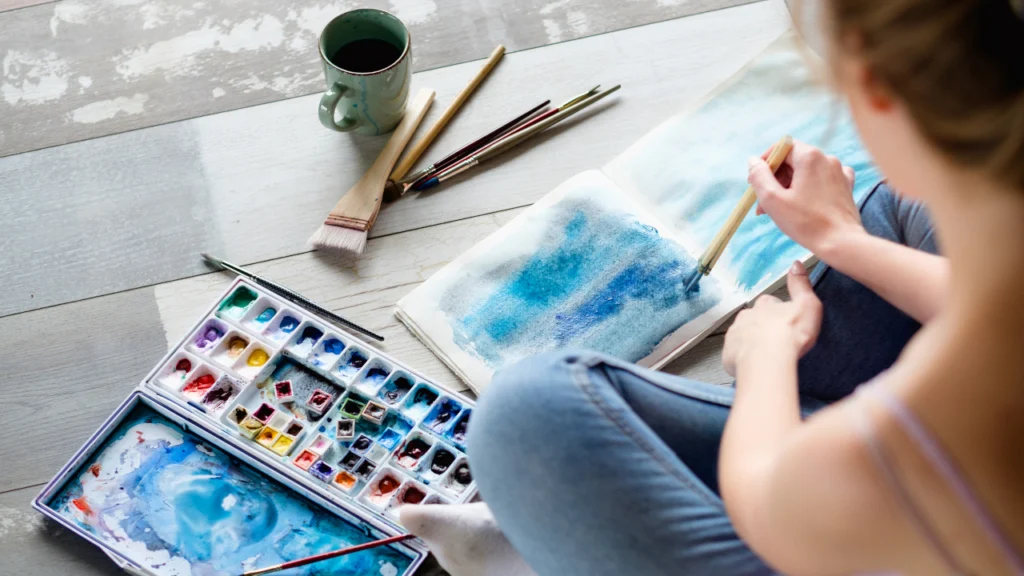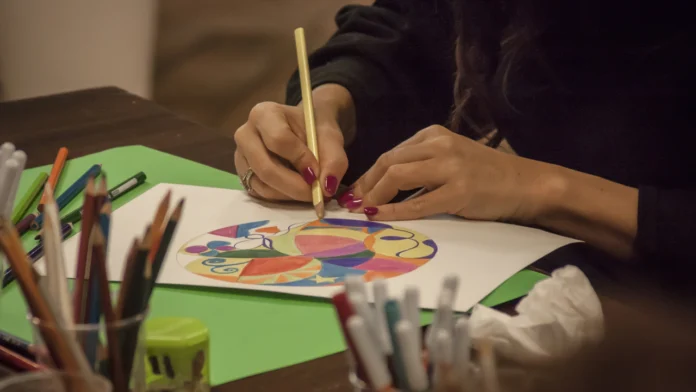Art therapy uses creativity and self-expression to help people convey their thoughts and emotions. Art therapy got its start in the United States in the 1940s when mental health practitioner Margaret Naumburg began publishing her work that employed art as a tool to help her clients.
She noted that some people found art therapy an easier and effective outlet for discussing uncomfortable emotions than traditional talk therapy because art provides a hands-on medium that can facilitate open and honest conversation. Since then, art therapy has increased in therapeutic programs.
Therapy.com is user supported. We receive a commission fee from purchases made through BetterHelp links.
Learn More
How Does Art Therapy Work?
If you’re trying to decide whether art therapy might be the right fit for you, it can be helpful to understand what to expect during a session with an art therapist.
When you meet for an expressive art therapy session, you’ll talk about your goals for the session. Your art therapist will listen to what you’d like to achieve and, together, choose a medium that’ll help you express yourself and reach your goals.
Activities your art therapist may offer include a mixture of drawing and sculpting. You can paint or draw how an experience made you feel or compose a self-portrait. Others take to writing, such as composing a postcard that isn’t actually sent or jotting notes in an art journal.
You can take a more abstract approach, such as using clay to engage in therapeutic sculpting or making a visual map or collage of your thoughts and emotions.
As you work through art therapy activities, your counselor can guide you through by asking you questions about your process. Your therapist might bring up the decision making process used to craft your art or ask questions about the emotions you’re expressing as you create your piece.

Your project may take several sessions to complete, or you might work on different pieces during each session. Either way, your therapist will wrap up your session with a debriefing to discuss your process.
You’ll discuss your emotional process while composing your project as well as the real-life situations tied to those feelings. Your therapist will discuss how you’ll move forward during your next session, and may ask you to continue to work on your art between sessions.
While art therapy can keep your mind and hands busy while discussing difficult emotions, engaging in creative activities fosters emotional and psychological healing. Sometimes, it’s hard to put words to difficult emotions. Expressive art therapy allows you to communicate through a non-verbal medium and offers greater insight into your feelings and experiences.
You may also find new-to-you creative activities that provide an outlet for stress. This can allow you to develop coping mechanisms that you can use in your daily life.
Therapy.com is user supported. We receive a commission fee from purchases made through BetterHelp links.
Learn More
Benefits of Art Therapy for Mental Health
Art therapy can enhance your mental well-being both in and out of your sessions. Creative expression offers a wide range of benefits to your emotional well-being, including the following:
- Enhanced self-expression: When we go through difficult experiences or are stuck in a negative pattern of thinking, it can be hard to express feelings in a way that makes sense to others or to ourselves. Art therapy offers the chance to gain emotional insight and understanding to help us develop the language required to share our feelings with others.
- Relaxation: Creative activities help lower levels of cortisol, which is a hormone your body produces during times of stress. Many also find that engaging in artistic activities can improve mood, reduce stress, and enhance focus in other areas of life.
- Improved self-esteem: Completing an art project from start to finish, regardless of your talent or effort, can provide a sense of accomplishment. This can increase self-esteem and confidence. Exploring new artistic skills with the guidance of your art therapist can help you grow as a person as you develop new skills that offer a sense of purpose.
Art therapy can benefit people with a wide range of mental health conditions, including:
- Anxiety: Research shows that art therapy can help alleviate symptoms associated with anxiety disorders, including social anxiety and panic disorders.
- PTSD: Art therapy can effectively reduce symptoms associated with post-traumatic stress disorder, or PTSD.
- Trauma: Trauma-informed art therapy makes it easier to discuss difficult events and allows you to reprocess painful issues with your therapist.
Art Therapy for Children
Artistic expression is an especially valuable form of therapy for children who may not have the vocabulary to fully express their feelings. In addition to helping kids more accurately express their feelings, art therapy promotes critical consciousness in children. They can more effectively explore social situations, develop empathy, and understand the circumstances of others.
FAQs
Common art therapy activities include painting, drawing, pottery, creating collages, and crafting.
While the types of activities and types of questions asked by therapists differ for children and adults, the core idea of art therapy is the same: to offer a new modality of non-verbal communication.
Who Can Benefit from Art Therapy?
Art therapy is beneficial for children, teens, and adults of all backgrounds. It’s most effective in treating the following:
- Stress: Research shows that creating art is an effective form of stress management. However, visual art creation isn’t the only creative output that can work to reduce stress. Music, dance, and participating in drama can also help keep stress at bay.
- Grief: It’s often hard to put grief into words. For some people, art therapy can help. Creating art as part of your grief management can help ground you as you move through the unpredictable and varied emotions that come with the grieving process.
- Other mental health challenges: It can be difficult to pinpoint the emotions behind anxiety, depression, and other mental health challenges. Mental health art therapy allows participants to lower their mental defenses and symbolically express feelings in a healthy way.
Those who do not see results from standard talk therapy might welcome the fresh alternative approach of expressive art therapy. Some people feel pressured to speak during talk therapy and may not feel comfortable or aren’t sure what to say. The hands-on aspect of art therapy can encourage clients to relax while processing tough emotions.
Finding an Art Therapist Near You
You might be wondering, “How do I find art therapy near me?” There are a few things to keep in mind.
First, it’s important to find a qualified art therapist. When searching, look for a Board Certified Art Therapist, or ATR-BC. Art therapists with ATR-BC certifications have passed the Art Therapy Credentials Board national exam.
Accredited therapists are also required to complete continuing education credits or retake the exam to ensure that they’re up-to-date on the latest best practices in art therapy.
Therapy.com is user supported. We receive a commission fee from purchases made through BetterHelp links.
Learn More
In addition to checking for credentials, it’s helpful to read online reviews to find out whether a particular art therapist may be a good fit for you. You may also want to check with your insurance company to learn which therapy providers in your area are in-network to help lower out-of-pocket costs.
As you’re narrowing down your list of potential art therapists, consider asking questions about their education and training. You can also inquire about their approach to therapy and how they assess successful art therapy.
You might also ask which types of art they enjoy. Knowing that your therapist is also an art enthusiast can make the process more engaging and even fun!
